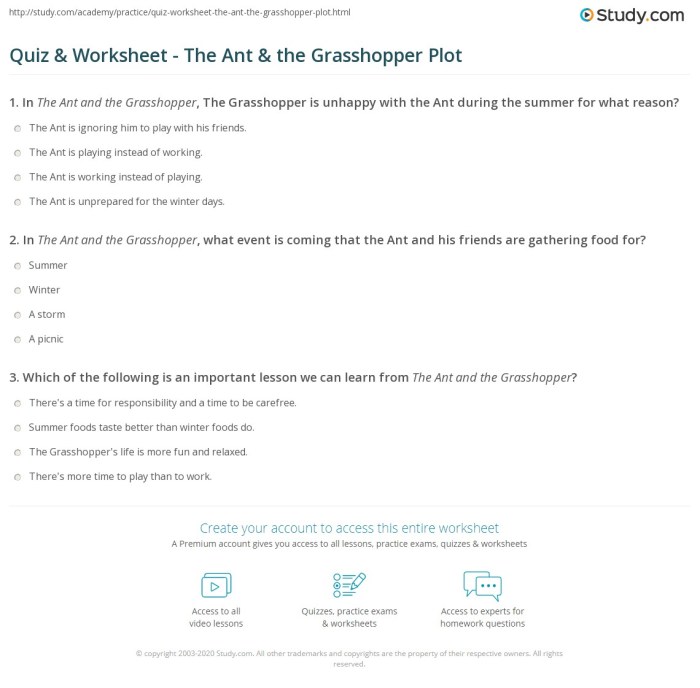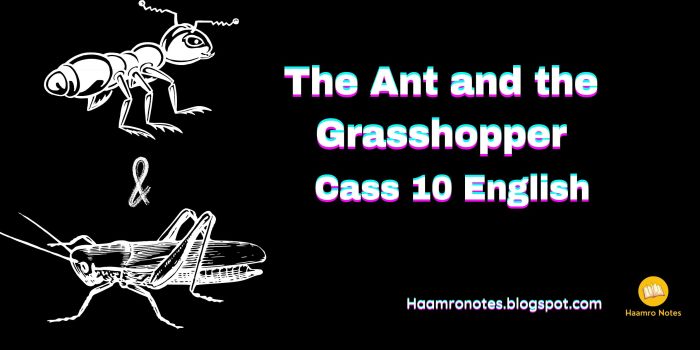The ant and the grasshopper questions and answers class 3 – Delving into the classic fable, “The Ant and the Grasshopper,” this exploration unravels the timeless moral lessons embedded within its narrative. Join us as we delve into the characters’ contrasting traits, the consequences of their actions, and the enduring relevance of this beloved tale.
The fable of “The Ant and the Grasshopper” has captivated generations, offering valuable insights into the virtues of hard work, planning, and responsibility. As we delve into the tale’s characters and their contrasting behaviors, we uncover the profound moral lessons that continue to resonate with readers of all ages.
Introduction to the Fable: The Ant and the Grasshopper

The fable of “The Ant and the Grasshopper” is a classic tale that teaches the importance of hard work, planning, and responsibility. It highlights the contrast between the industrious ant and the carefree grasshopper, and illustrates the consequences of their respective actions.
Characters and Their Traits
The fable features two main characters: the ant and the grasshopper. The ant is depicted as hardworking, industrious, and forward-thinking. It spends the summer months gathering food and preparing for the cold winter ahead. In contrast, the grasshopper is carefree, irresponsible, and spends its time singing and playing without a thought for the future.
The Ant’s Perspective
The ant is characterized by its diligence and foresight. It understands the importance of planning and preparation. Throughout the summer, it tirelessly gathers food and stores it away for the winter months. The ant’s industrious nature ensures that it has ample supplies to sustain itself when food becomes scarce.
The Grasshopper’s Perspective, The ant and the grasshopper questions and answers class 3
The grasshopper, on the other hand, is depicted as a carefree and irresponsible creature. It spends its days singing and playing, without any regard for the future. The grasshopper relies on the ant’s generosity and assumes that it will be provided for when winter comes.
This carefree attitude ultimately leads to its downfall.
Consequences of Their Actions
The fable highlights the consequences of the ant’s and the grasshopper’s actions. The ant’s hard work and planning pay off when winter arrives. It has ample food to sustain itself and remains comfortable throughout the cold months. In contrast, the grasshopper’s carefree attitude and lack of preparation lead to its downfall.
When winter arrives, it has no food and is forced to endure the cold and hunger.
Moral Lesson of the Fable

The moral lesson of the fable is clear: hard work, planning, and responsibility are essential for success in life. The ant’s industrious nature and foresight serve as an example of how to live a responsible and fulfilling life. The grasshopper’s carefree attitude and lack of preparation serve as a cautionary tale about the consequences of laziness and irresponsibility.
Applications in Real Life
The moral lesson of the fable can be applied in many real-life situations. For example, students who study hard and prepare for exams are more likely to succeed than those who procrastinate and do not put in the effort. Similarly, employees who are hardworking and responsible are more likely to be successful in their careers than those who are lazy and irresponsible.
Modern Interpretations of the Fable
The fable of “The Ant and the Grasshopper” has been interpreted and adapted in many different ways over the centuries. One modern interpretation is the story of the “The Lazy Man and the Industrious Man,” which tells a similar tale about the importance of hard work and responsibility.
Another modern interpretation is the fable of “The Squirrel and the Chipmunk,” which teaches a similar lesson about the importance of planning and preparation.
Quick FAQs: The Ant And The Grasshopper Questions And Answers Class 3
What is the main lesson taught by the fable “The Ant and the Grasshopper”?
The fable teaches the importance of hard work, planning, and responsibility. It shows that those who work hard and plan for the future will be rewarded, while those who are lazy and irresponsible will suffer the consequences.
What are the key differences between the ant and the grasshopper in the fable?
The ant is hardworking, responsible, and plans for the future. The grasshopper is lazy, irresponsible, and lives only for the present.
What are the consequences of the ant’s and the grasshopper’s actions in the fable?
The ant’s hard work and planning pay off when winter comes and it has plenty of food to eat. The grasshopper’s laziness and irresponsibility lead to it starving during the winter.